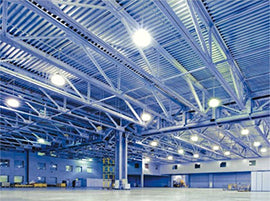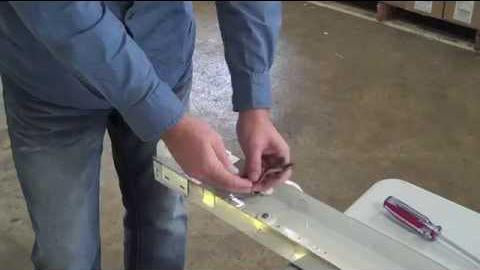How much does it cost to operate your metal halide fixtures? We help you do the math.

The upfront costs of a metal halide vs LED may be low but, when maintenance and electricity costs are taken into account the overall cost is rather high. Let’s look at the math behind calculating the operating costs.
Determine the number of actual watts used by one of your fixtures. Use the fixture wattage + wattage used by the associated ballast. Typical wattages are shown below.
- 175 watt fixture = 205 actual watts
- 250 watt fixture = 290 actual watts
- 400 watt fixture = 458 actual watts
- 1000 watt fixture = 1081 actual watts
Multiply the watts that your metal halide fixture uses by the total number of fixtures that you have to determine total watts. (single fixture watts) x (number of fixtures) = TOTAL WATTS
Example: (290 watts) x (30 fixtures) = 8700 total watts
Divide total watts (from step 2) by 1000 to determine total kilowatts.
TOTAL WATTS/1000 = TOTAL KILOWATTS
Example: 8700 total watts / 1000 = 8.7 total kilowatts
Determine how many hours your lights are on per year. This doesn’t need to be exact, just a rough estimate. Start by determining how long they are on per day and then multiply number of days per year. For our example, we will use 3,000 hours per year.
Calculate kilowatt hours, which are typically used for billing units for energy delivered by electric utilities. (total kilowatts) x (hours per year) = KILOWATT HOURS
Example: 8.7 x 3,000 = 26,100 kilowatt hours
Determine the amount charged by your electric utility per kilowatt hour and calculate annual energy cost. (price per kilowatt hour) x (kilowatt hours) =
Example: $0.09 x 26,100 = $2,349.00
Calculate how much it costs per year for each light fixture that you have. (annual energy cost) / (number of fixtures) = ANNUAL ENERGY COST PER FIXTURE
Example: $2,349.00 / 30 = $78.30
The final calculations for annual energy costs are then added to the initial cost of the light fixtures and their associated bulbs. It’s also worth considering metal halide vs LED power consumption. One of the main issues with metal highlight bulbs is that they tend to lose 50% of their light output half way through their typical lifespan. This is not the case for high pressure sodium, LED and induction alternatives. These alternatives also have longer average lifespans. They may have higher upfront costs (especially LEDs), but energy savings and lower maintenance costs realized over a period of time will offset this. Take some time to look at our lighting selection at Warehouse-Lighting.com or call to speak to one of our lighting experts about your lighting needs.

Retro a Fluorescent Strip Fixture to LED
When it comes to saving energy and money with your lighting solutions, LED technology is the way to go. If you already have fixtures in place that you are looking to convert for energy-savings, ...
Watch Video
Retro a Fluorescent Strip Fixture to LED
When it comes to saving energy and money with your lighting solutions, LED technology is the way to go. If you already have fixtures in place that you are looking to convert for energy-savings, ...
Watch Video
Difference Between T5 and T8 Low Bay Fluorescent Lighting Fixtures
Finding the right lighting solution for your location means comparing your options. When choosing between two types of lighting, there are many factors you may want to consider. For your l...
Watch Video High Bay LED Lighting
High Bay LED Lighting
 Industrial Low Bay Lighting
Industrial Low Bay Lighting
 Industrial Strip Lights
Industrial Strip Lights
 Vapor Tight Lighting
Vapor Tight Lighting
 LED Shop Lights
LED Shop Lights
 Hazardous Area / Explosion Proof Lighting
Hazardous Area / Explosion Proof Lighting
 Loading Dock Lights
Loading Dock Lights
 Construction / Portable Lighting
Construction / Portable Lighting
 Industrial Ceiling Fans
Industrial Ceiling Fans
 LED Work Lights
LED Work Lights
 Networked Controlled Lighting
Networked Controlled Lighting
 NEW Warehouse Lighting Fixtures
NEW Warehouse Lighting Fixtures
 Clearance
Clearance
 Troffer Lights
Troffer Lights
 LED Flat Panel Lights
LED Flat Panel Lights
 Drop Ceiling Lights
Drop Ceiling Lights
 Suspended LED Lights
Suspended LED Lights
 LED Cylinder Lights
LED Cylinder Lights
 Exit / Emergency
Exit / Emergency
 Wrap Lighting Fixtures
Wrap Lighting Fixtures
 Gooseneck and Barn Lights
Gooseneck and Barn Lights
 Stairway & Corridor Lighting
Stairway & Corridor Lighting
 Hospital Bed Lights
Hospital Bed Lights
 Commercial Sign Lights
Commercial Sign Lights
 Recessed Lighting
Recessed Lighting
 Wafer Lighting
Wafer Lighting
 RGB LED Lights
RGB LED Lights
 Grow Lights
Grow Lights
 UV Disinfecting Lights & Air Purifier Fixtures
UV Disinfecting Lights & Air Purifier Fixtures
 Refrigeration Lighting
Refrigeration Lighting
 LED Flood Lights
LED Flood Lights
 Outdoor Wall Lights
Outdoor Wall Lights
 LED Area Lights
LED Area Lights
 Parking Lot Lights & Poles
Parking Lot Lights & Poles
 Outdoor Post Top Lights
Outdoor Post Top Lights
 LED Stadium Lighting
LED Stadium Lighting
 Canopy Lights
Canopy Lights
 Security & Motion Sensor Lights
Security & Motion Sensor Lights
 LED Bollard Lights
LED Bollard Lights
 Outdoor LED Linear Light Fixtures
Outdoor LED Linear Light Fixtures
 Solar Powered LED Lighting
Solar Powered LED Lighting
 Dusk to Dawn Lights
Dusk to Dawn Lights
 Landscape Lighting
Landscape Lighting
 Outdoor String Lights
Outdoor String Lights
 Coastal Wildlife Lighting
Coastal Wildlife Lighting
 Outdoor House Lights
Outdoor House Lights
 Architectural Linear Lights
Architectural Linear Lights
 Architectural Grid Mount Lights
Architectural Grid Mount Lights
 Architectural Round Pendant Lights
Architectural Round Pendant Lights
 Architectural Square Linear Lights
Architectural Square Linear Lights
 Architectural X-Shaped Linear Lights
Architectural X-Shaped Linear Lights
 Architectural LED Wall Packs
Architectural LED Wall Packs
 Ceiling Fans
Ceiling Fans
 Ceiling Lights
Ceiling Lights
 Chandelier Lights
Chandelier Lights
 Pendant Lighting
Pendant Lighting
 Island Lights
Island Lights
 Track Lighting
Track Lighting
 Under Cabinet Lighting
Under Cabinet Lighting
 Vanity Lights
Vanity Lights
 Wall Sconces
Wall Sconces
 LED Tape Lights
LED Tape Lights
 LED Mirrors
LED Mirrors
 LED Light Bulbs
LED Light Bulbs
 LED Tube Lights
LED Tube Lights
 LED Corn Lights
LED Corn Lights
 Vintage LED Bulbs
Vintage LED Bulbs
 Decorative LED Bulbs
Decorative LED Bulbs
 Fluorescent Light Bulbs
Fluorescent Light Bulbs
 Metal Halide Lamps
Metal Halide Lamps
 LED Magnetic Strip Retrofit Kits
LED Magnetic Strip Retrofit Kits
 LED Strip Light Retrofit Kits
LED Strip Light Retrofit Kits
 High Bay LED Retrofit Kits
High Bay LED Retrofit Kits
 LED Troffer Retrofit Kits
LED Troffer Retrofit Kits
 LED Wall Pack Retrofit
LED Wall Pack Retrofit
 LED Street Light Retrofit Kits
LED Street Light Retrofit Kits
 Recessed Lighting LED Retrofit Kits
Recessed Lighting LED Retrofit Kits
 Ballasts & Drivers
Ballasts & Drivers
 Emergency Ballast For LED & Fluorescent Lights
Emergency Ballast For LED & Fluorescent Lights
 Electrical Supplies & Mounting Kits
Electrical Supplies & Mounting Kits
 Electrical Tools
Electrical Tools
 Switches & Receptacles
Switches & Receptacles
 Electrical Power Cords
Electrical Power Cords
 Sensors and Timers
Sensors and Timers
 Smart Home Automation
Smart Home Automation
 High Bay Occupancy Sensors
High Bay Occupancy Sensors
 Electric Vehicle Chargers
Electric Vehicle Chargers
 Hand Dryers
Hand Dryers
 LED Shop Lights
LED Shop Lights
 Garage LED Light Fixtures
Garage LED Light Fixtures
 Office Lights
Office Lights
 Classroom Lights
Classroom Lights
 Church Lights
Church Lights
 Gym Lighting
Gym Lighting
 Factory Lights
Factory Lights
 Hospital Lights
Hospital Lights
 Walkway Lights
Walkway Lights
 Parking Lot Lights
Parking Lot Lights
 Exterior Building Lights
Exterior Building Lights
 Sports Lighting
Sports Lighting
 Airport Lights
Airport Lights
 NSF Rated Lights
NSF Rated Lights
 Restaurant Lights
Restaurant Lights
 Corridor Lights
Corridor Lights
 Barn Lighting
Barn Lighting




